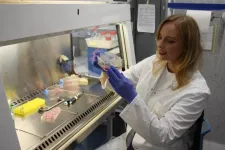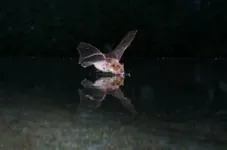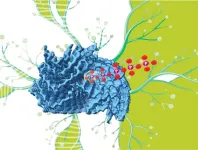(Press-News.org) Researchers at the Centre for Genomic Regulation (CRG) in Barcelona have created the first blueprint of the human spliceosome, the most complex and intricate molecular machine inside every cell. The scientific feat, which took more than a decade to complete, is published today in the journal Science.
The spliceosome edits genetic messages transcribed from DNA, allowing cells to create different versions of a protein from a single gene. The vast majority of human genes – more than nine in ten – are edited by the spliceosome. Errors in the process are linked to a wide spectrum of diseases including most types of cancer, neurodegenerative conditions and genetic disorders.
The sheer number of components involved and the intricacy of its function has meant the spliceosome has remained elusive and uncharted territory in human biology – until now.
The blueprint reveals that individual components of the spliceosome are far more specialised than previously thought. Many of these components have not been considered for drug development before because their specialised functions were unknown. The discovery can unlock new treatments that are more effective and have fewer side effects.
“The layer of complexity we’ve uncovered is nothing short of astonishing. We used to conceptualise the spliceosome as a monotonous but important cut and paste machine. We now see it as a collection of many different flexible chisels that allow cells to sculpt genetic messages with a degree of precision worthy of marble sculpting grandmasters from antiquity. By knowing exactly what each part does, we can find completely new angles to tackle a wide spectrum of diseases,” says ICREA Research Professor Juan Valcárcel, lead author of the study and researcher at the CRG.
The most complex molecular machine in human biology
Every cell in the human body relies on precise instructions from DNA to function correctly. These instructions are transcribed into RNA, which then undergoes a crucial editing process called splicing. During splicing, non-coding segments of RNA are removed, and the remaining coding sequences are stitched together to form a template or recipe for protein production.
While humans have about 20,000 protein-coding genes, splicing allows the production of at least five times as many proteins, with some estimates suggesting humans can create more than 100,000 unique proteins.
The spliceosome is the collection of 150 different proteins and five small RNA molecules which orchestrate the editing process, but until now, the specific roles of its numerous components were not fully understood. The team at the CRG altered the expression of 305 spliceosome-related genes in human cancer cells one by one, observing the effects on splicing across the entire genome.
Their work revealed that different components of the spliceosome have unique regulatory functions. Crucially, they found that proteins within the spliceosome's core are not just idle support workers but instead have highly specialised jobs in determining how genetic messages are processed, and ultimately, influence the diversity of human proteins.
For example, one component selects which RNA segment is removed. Another component ensures cuts are made at the right place in the RNA sequence, while another one behaves like a chaperone or security guard, keeping other components from acting too prematurely and ruining the template before its finished.
The authors of the study compare their discovery to a busy post-production set in film or television, where genetic messages transcribed from DNA are assembled like raw footage.
“You have many dozens of editors going through the material and making rapid decisions on whether a scene makes the final cut. It’s an astonishing level of molecular specialisation at the scale of big Hollywood productions, but there’s an unexpected twist. Any one of the contributors can step in, take charge, and dictate the direction. Rather than the production falling apart, this dynamic results in a different version of the movie. It’s a surprising level of democratization we didn’t foresee,” says Dr. Malgorzata Rogalska, co-corresponding author of the study.
Cancer’s ‘Achilles’ Heel’
One of the most significant findings in the study is that the spliceosome is highly interconnected, where disrupting one component can have widespread ripple effects throughout the entire network.
For example, the study manipulated the spliceosome component SF3B1, which is known to be mutated in many cancers including melanoma, leukaemia and breast cancer. It is also a target for anti-cancer drugs, though the exact of mechanisms of action have been unclear – until now.
The study found that altering the expression of SF3B1 in cancer cells sets off a cascade of events that affected a third of the cell’s entire splicing network, causing a chain reaction of failures which overwhelm the cell's ability to fuel growth.
The finding is promising because traditional therapies, for example those targeting mutations in DNA, often cause cancer cells to become resistant. One of the ways cancers adapt is by rewiring their splicing machinery. Targeting splicing can push diseased cells past a tipping point that cannot be compensated for, leading to their self-destruction.
“Cancer cells have so many alterations to the spliceosome that they are already at the limit of what’s biologically plausible. Their reliance on a highly interconnected splicing network is a potential Achilles' heel we can leverage to design new therapies, and our blueprint offers a way of discovering these vulnerabilities” says Dr. Valcárcel.
“This pioneering research illuminates the complex interplay between components of the spliceosome, revealing insight into its mechanistic and regulatory functions. These findings not only advance our understanding of spliceosome function but also open potential opportunities to target RNA processing for therapeutic interventions in diseases associated with splicing dysregulation” says Dom Reynolds, CSO at Remix Therapeutics, a clinical stage biotechnology company in Massachusetts who collaborated with the CRG on the study.
Bringing splicing treatments into the mainstream
Apart from cancer, there are many other diseases caused by faulty RNA molecules produced by mistakes in splicing. With a detailed map of the spliceosome, which the authors of the study have made publicly-available, researchers can now help pinpoint exactly where the splicing errors are occurring in a patient's cells.
“We wanted this to be a valuable resource for the research community,” says Dr. Valcárcel. “Drugs correcting splicing errors have revolutionised the treatment of rare disorders like spinal muscular atrophy. This blueprint can extend that success to other diseases and bring these treatments into the mainstream,” he adds.
“Current splicing treatments are focused on rare diseases, but they are just the tip of the iceberg. We are moving into an era where we can address diseases at the transcriptional level, creating disease-modifying drugs rather than merely tackling symptoms. The blueprint we've developed paves the way for entirely new therapeutic approaches. It's only a matter of time,” concludes Dr. Rogalska.
END
First blueprint of the human spliceosome revealed
Researchers detail the inner workings of the most complex and intricate molecular machine in human biology
2024-10-31
ELSE PRESS RELEASES FROM THIS DATE:
The harmful frequency and reach of unhealthy foods on social media
2024-10-31
An analysis of social media posts that mention food and beverage products finds that fast food restaurants and sugar sweetened beverages are the most common, with millions of posts reaching billions of users over the course of a year. The study, published in the open access journal PLOS Digital Health, highlights the sheer volume of content normalising unhealthy eating, and argues that policies are needed to protect young people in the digital food environment.
Obesity is a health challenge around the world and food environments, including in the digital space, can influence ...
Autistic traits shape how we explore
2024-10-31
People with stronger autistic trails showed distinct exploration patterns and higher levels of persistence in a computer game, ultimately resulting in better performance than people with lower scores of autistic traits, according to a new study published this week in PLOS Computational Biology by Francesco Poli of Radboud Universiteit, the Netherlands, and colleagues.
Scientists know that individuals display curiosity and explore their environments to learn. How a person selects what they want to explore plays a pivotal role in how they learn and research has shown that exploration levels are highly variable across ...
UCLA chemists just broke a 100-year-old rule and say it’s time to rewrite the textbooks
2024-10-31
Key takeaways
According to Bredt's rule, double bonds cannot exist at certain positions on organic molecules if the molecule's geometry deviates too far from what we learn in textbooks.
This rule has constrained chemists for a century.
A new paper in Science shows how to make molecules that violate Bredt’s rule, allowing chemists to find practical ways to make and use them in reactions.
UCLA chemists have found a big problem with a fundamental rule of organic chemistry that has been around for 100 years — it’s ...
Uncovered: the molecular basis of colorful parrot plumage
2024-10-31
A single enzyme fine-tunes red and yellow pigments in parrots’ polychromatic plumage, according to a new study. The findings reveal new insights into the molecular mechanisms underlying the evolution and display of color variation in one of nature’s most colorful birds. Colors play a central role in ecological adaptation and communication in the natural world. This is particularly true for birds, which are especially notable among animals for their wide range of vibrant plumage colors and patterns. Among birds, ...
Echolocating bats use acoustic mental maps to navigate long distances
2024-10-31
By blindfolding Kuhl's pipistrelle bats and tracking their movements with novel GPS technology, researchers show that the tiny creatures can navigate over several kilometers using only echolocation. The findings highlight the animal’s ability to create and use detailed mental acoustic maps of their surroundings. Echolocating bats are known for their ability to nimbly avoid obstacles and catch tiny prey using only sound. However, echolocation is short-ranged and highly directional, allowing for the detection of large objects within only a few dozen meters, limiting its effectiveness for navigation compared to other senses, like vision. ...
Sugar rationing in early life lowers risk for chronic disease in adulthood, post-World War II data shows
2024-10-31
Early-life sugar restriction – beginning in utero – can protect against diabetes and hypertension later in life, according to a new study leveraging data from post-World War II sugar rationing in the United Kingdom. The findings highlight critical long-term health benefits from reduced sugar intake during the first 1000 days of life. The first 1000 days from conception – from gestation until age 2 – is a critical period for long-term health. Poor diet during this window has been linked to negative health outcomes in adulthood. Despite dietary guidelines recommending zero added sugar in early life, high sugar exposure is ...
Indigenous population expansion and cultural burning reduced shrub cover that fuels megafires in Australia
2024-10-31
Indigenous burning practices in Australia once halved shrub cover, reducing available fuels and limiting wildfire intensity for thousands of years, but the removal of these practices following European colonization has led to an increase in the tinder that has fueled today’s catastrophic megafires, researchers report. The findings suggest that reintroducing cultural burning practices could provide a strategy to curb future fires. “Through detailed histories of Indigenous burning regimes across the world and Indigenous-led collaborations in contemporary wildfire management ...
Echolocating bats use an acoustic cognitive map for navigation
2024-10-31
Echolocating bats have been found to possess an acoustic cognitive map of their home range, enabling them to navigate over kilometer-scale distances using echolocation alone. This finding, recently published in Science, was demonstrated by researchers from the Max Planck Institute of Animal Behavior, the Cluster of Excellence Centre for the Advanced Study of Collective Behaviour at the University of Konstanz Germany, Tel Aviv University, and the Hebrew University of Jerusalem, Israel.
Would you be able to instantly recognize ...
Researchers solve medical mystery of neurological symptoms in kids
2024-10-31
Most people who visit a doctor when they feel unwell seek a diagnosis and a treatment plan. But for some 30 million Americans with rare diseases, their symptoms don’t match well-known disease patterns, sending families on diagnostic odysseys that can last years or even lifetimes.
But a cross-disciplinary team of researchers and physicians from Washington University School of Medicine in St. Louis and colleagues from around the world has solved the mystery of a child with a rare genetic illness that did not fit any known disease. The team found a link between the child’s neurological symptoms and a genetic change that affects how proteins ...
Finding a missing piece for neurodegenerative disease research
2024-10-31
Research led by the University of Michigan has provided compelling evidence that could solve a fundamental mystery in the makeup of fibrils that play a role in Alzheimer's, Parkinson's and other neurodegenerative diseases.
"We've seen that patients have these fibril structures in their brains for a long time now," said Ursula Jakob, senior author of the new study. "But the questions are what do these fibrils do? What is their role in disease? And, most importantly, can we do something to get rid of them if they are responsible for these devastating diseases?"
Although the new finding does not explicitly answer those questions, it may provide a missing ...
LAST 30 PRESS RELEASES:
Air pollution exposure and birth weight
Obstructive sleep apnea risk and mental health conditions among older adults
How talking slows eye movements behind the wheel
The Ceramic Society of Japan’s Oxoate Ceramics Research Association launches new international book project
Heart-brain connection: international study reveals the role of the vagus nerve in keeping the heart young
Researchers identify Rb1 as a predictive biomarker for a new therapeutic strategy in some breast cancers
Survey reveals ethical gaps slowing AI adoption in pediatric surgery
Stimulant ADHD medications work differently than thought
AI overestimates how smart people are, according to HSE economists
HSE researchers create genome-wide map of quadruplexes
Scientists boost cell "powerhouses" to burn more calories
Automatic label checking: The missing step in making reliable medical AI
Low daily alcohol intake linked to 50% heightened mouth cancer risk in India
American Meteorological Society announces Rick Spinrad as 2026 President-Elect
Biomass-based carbon capture spotlighted in newly released global climate webinar recording
Illuminating invisible nano pollutants: advanced bioimaging tracks the full journey of emerging nanoscale contaminants in living systems
How does age affect recovery from spinal cord injury?
Novel AI tool offers prognosis for patients with head and neck cancer
Fathers’ microplastic exposure tied to their children’s metabolic problems
Research validates laboratory model for studying high-grade serous ovarian cancer
SIR 2026 delivers transformative breakthroughs in minimally invasive medicine to improve patient care
Stem Cell Reports most downloaded papers of 2025 highlight the breadth and impact of stem cell research
Oxford-led study estimates NHS spends around 3% of its primary and secondary care budget on the health impacts of heat and cold in England
A researcher’s long quest leads to a smart composite breakthrough
Urban wild bees act as “microbial sensors” of city health.
New study finds where you live affects recovery after a hip fracture
Forecasting the impact of fully automated vehicle adoption on US road traffic injuries
Alcohol-related hospitalizations from 2016 to 2022
Semaglutide and hospitalizations in patients with obesity and established cardiovascular disease
Researchers ‘listen in’ to embryo-mother interactions during implantation using a culture system replicating the womb lining
[Press-News.org] First blueprint of the human spliceosome revealedResearchers detail the inner workings of the most complex and intricate molecular machine in human biology





